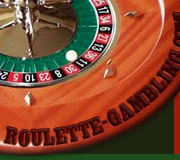
|
|
| |
| Roulette Gambling recommends some great places to play roulette. |
| |
| Always fun to play, but more fun to win - here's some winning roulette strategy. |
| |
| Chances are if you're here you already know a little something about the game of roulette, but if not - here's a quick introduction on online roulette. |
| |
| Roulette history - read up on how this 300 year old casino game came to be. |
| |
| Roulette rules - how to play roulette, how to bet, table rules, etc. |
| |
| Not familiar with the lingo? From singles to street bets, we've got you covered. |
| |
| A collection of more gambling links for you. |
| |
| News about roulette and online casinos. |
The Science of RouletteSeptember 20, 2007 Roulette is one of the “glamour” games of gambling. It is the famed game often used in movie scenes in which high class gamblers will wager on where the ball will land after the wheel stops spinning. Roulette offers countless different wagers and wagering strategies as you can bet on, for starters, what number the ball will land on, (one through thirty-six and zero and double zero). You can also wager on whether the ball will land on a black or red square and or the dreaded zero/double zero green square. You can also wager on odds, evens, low, medium, or high numbers. You can wager on a group of numbers tied together on the board, and on and on. At an online casino, the natural excitement of roulette is taken to the next level as the pace of play is quicker and there are far more tables with a wide variety of betting limits and options that could never hope to be matched at an on-site/in-person casino. There are as many roulette betting systems as there are players and, in fact, there are many books available on how to best play roulette. One thing is for sure, you cannot erase the house edge of 5.26 percent for American roulette or even the more generous 2.75 percent for European roulette. It’s how a gambler works within that house edge that ultimately determines whether or not a gambler succeeds. One theory that has been tried over and over again since the beginning of time is known as the “Martingale Theory” in which a gambler will keep doubling up his bets on even money wagers such as odds or evens, blacks or reds, or high and lows. Ultimately, the Martingale theory won’t hold against that house edge. |